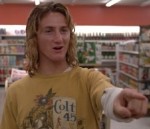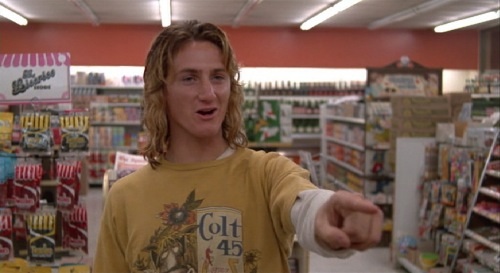▼
by William Orem
The earliest Christian documents we have are not the four canonical gospels—
Johnny-come-latelies written, anonymously, by Greek-speaking theologians far from the events they describe. Rather, they are the epistles of Paul, a Roman Jew who was signally responsible for both the character and spread of the new faith. Paul’s Jesus Christ was primarily a mystical being, met in visions: to judge by his letters, he may not even have believed Christ lived in a body on earth. The relationship of Paul, and the other epistle writers, to Gnosticism—with its central thesis that the body is a low, scurrilous thing, a mere trap for the spirit—is a fascinating subject in itself. Whatever Paul’s metaphysics, though, the deep concern with which he viewed the flesh is famous.
In his first letter to the church at Corinth, Paul hotly chastises the brethren for behavior unbecoming of the saved. Christian brothers have been, in the colorful King James elocution, “fornicating”; Christian brothers have been visiting prostitutes; one has been having sex with his mother (stepmother, if you wish: “his father’s wife”). Paul seems also to be stepping into an active debate over whether sex should be permissible at any time, inside marriage or out.
The apostle lays into the libertines here with some of his most memorable ire:
“Be not deceived: neither fornicators, nor idolaters, nor adulterers, nor effeminate, nor abusers of themselves with mankind [ . . . ] shall inherit the kingdom of God.” (1 Cor 6:9-10) “Know ye not that your bodies are the members of Christ? Shall I then take the members of Christ, and make them the members of an harlot?” (1 Cor 6:15) “Flee fornication. Every sin that a man doeth is without the body; but he that committeth fornication sinneth against his own body.” (1 Cor 6:18).
“It is well for a man not to touch a woman,” Paul sums up his position (1 Cor. :1), drawing an association between holiness and sexlessness that would echo for millennia. Ideally, everyone should just be celibate, as the world is about to end anyway. He himself avoids sex altogether—though some, Bishop John Shelby Spong as a recent example, have suspected a homosexual subtext among the guilty denials. Regardless of the source of Paul’s anxiety, his message is clear: If you absolutely must, go ahead and have sex with your wives, just to keep your animal lust from driving you to worse things. But, honestly, God would like it best if people didn’t touch each other down there . . . or here, or here . . . or under there . . . at all.
And so forward through the centuries. Catholicism has been marked by a recurrence, among its primary names, of deep confusion and alarm regarding sexual drive. One thinks, even at a quick glance, of Origen, the Church Father who took a knife to his own genitals (inspired by this act, a Christian sect called the Valesians are reported to have castrated not only themselves, but others). One thinks of Augustine, who wallowed in a decade of unbridled, if guilt-poisoned, libertinism—“Lord, make me chaste, but not yet,” was his prayer—before encountering Paul’s own Put on the Lord Jesus Christ, and make no provision for the flesh, to fulfill the lusts thereof, whereupon he became a great condemner of sex all around. Sexual desire is mud, he tells us in Confessions; it is chains, thorns, an itching, open sore. One thinks of Aquinas, who, in his Summa Theologica, turned the most powerful intellect of the 13th century to the pressing matter of all “monstrous and bestial manners of copulation” (Is masturbation a worse sin than rape? Is “nocturnal pollution” an offense to the Almighty?)
It was to Aquinas, by the way, that the recently self-deposed Pope Benedict advocated the modern, science and reason-based West needed to return. Benedict was also a great Augustinian, once saying Confessions is the only book other than the Bible he would need on a desert island. This was in the early days of Benedict’s papacy, before his name was forever linked to a massive, international practice of both sheltering and enabling Catholic priests who rape children.
◆
Sex, as it turns out, is a normal function. Some 250,000 years of natural selection acting on our own species, with perhaps a billion years of laying the biological groundwork before that, have formed us in exactly this way. The wandering symphony of sexual behaviors is a great many things, but first of all, it is human.
This basic recognition has serious consequences for any orthodoxy that seeks to subdue, or vilify, healthy sexual expression. In an imaginary world, leaving the body behind may be commendable. In this one, the result can only be great numbers of people who are lonely and unfulfilled; sexually repressed, with the consequent psychological effects; sexually covert, living a life of hypocrisy and self-alienation; or, in the worst cases, pathological.
In his book Dilemma: A Priest’s Struggle With Faith and Love, Father Albert Cutié makes a blunt statement:
“After several years in the ministry, I came to the understanding that most of my priest acquaintances—with very few exceptions—fell into three basic categories, with some falling into two or even three of them:
1. Those removed from the Church
2. Those accused of sexual or other crimes
3. Those who felt disgruntled and/or isolated.”
Cutié, known throughout the U.S., Spain and Latin America for his radio and TV outreach, was “outed” having a sexual relationship with a woman. Rather than retiring in shame, however, he converted publicly to Episcopalianism, married his love, and started a family. (By contrast, Thomas Merton, a previous Catholic apologist of international repute, kept his relationship with a woman almost three decades his junior a secret.) Cutié’s insider exposé of the celibacy myth makes harrowing reading for anyone raised to believe that all clergy . . . or even the majority . . . follow Vatican instruction on matters of sexuality.
In a gentle, almost crestfallen voice, “Padre Alberto” details the astonishing number of seminarians, priests, bishops and others who lead active sex lives:
“There are more priests and women in this situation than anyone can imagine. I once met a bishop in a Latin American diocese who confided in me that every priest in his diocese had a girlfriend; most of his priests had fathered children in these relationships. [ . . . ] But, with the passage of time, and as my ministry in the media took me all around the world, I began to understand how impossible celibacy is for most people. The phenomenon of Roman Catholic priests who are officially celibate but leading secret lives is present all over the world [ . . . ]”
Nor are all “men of the cloth” men. Just recently I had lunch with ex-nun Mary Johnson, whose excellent memoir An Unquenchable Thirst chronicles her time in Mother Theresa’s order. While working in the Missionaries of Charity, she had a lesbian relationship with a fellow sister who turned out to be a sexual predator; a love affair with a priest; and a personal awakening to the cost of loneliness that caused her to leave the Church altogether.
Among the covert, of course, is the great number of male homosexuals. Father Donald Cozzens, in The Changing Face of the Priesthood, holds that some 60% of Catholic clergy belong in this latter category. Cutié, in a recent television interview, accepted this rough figure, further underscoring how many of these gay men are “promiscuous”—meaning actively engaged in sex with multiple partners. Such claims have been vocally challenged by their detractors, to be sure; but anything remotely like what these ordained men are describing would make the Vatican’s celibacy rule, its anti-homosexuality stance, and its position on sexual behaviors in general, a farce.
For relatively healthy clergy—gay, straight, or bi—and for their parishioners, the cost in hypocrisy alone of all this duplicity must be extreme. A cleric who is using prostitutes while preaching that even masturbation is a sin is a terribly fractured entity. Beyond such cases, though, stand the truly pathological: those clergy whose sexuality is misshapen to the point of predation.
The very existence of an organization like SNAP—the Survivor Network of those Abused by Priests—tells a chilling tale. According to BishopAccountability.org, a public database by lay Catholics on the sex abuse scandal, “Thousands of Catholic clergy and religious have raped and sodomized tens of thousands of children—perhaps more than 100,000 children—since 1950.”
This figure is jaw-dropping.100,000 children, in a crime so painful it is almost certainly underreported. That’s over 1,500 assaults every year, or another Jerry Sandusky striking every six hours, every day, since Quo Vadis was on the big screen.
Can such an evil possibly be happening? Must it not all be some terrible mistake, or malicious rumor—the “few bad apples” defense?
The Vatican, whose Cardinal Sodano dismissed clerical abuse as “idle gossip” in 2010, first tried to downplay the extremity of its problem. (Sodano now has his own scandal, involving his having pressured then-cardinal Ratzinger not to investigate sex abuse charges against Archbishop Hans Hermann Groër and Father Marcial Maciel, of whom more below.) Yet huge numbers of cases continued to be revealed—in the U.S.; in the Netherlands; in Austria; in Poland; in Canada; in France; in Germany. Settlement cases, according to AP, had already cost the Church two billion dollars in 2007; Bishop-Accountability puts it currently past three billion. In America, whole dioceses had to declare bankruptcy. The more Catholic the country, it seemed, the more profound the pain: in Ireland, government investigations brought to light an astonishing 15,000 cases and cover-ups, going back fifty years—causing four separate Bishops to offer resignation and dealing the Irish church a blow from which it may never recover.
When denial became impossible, Pope Benedict blamed society. In his year-end address to Vatican bishops and cardinals, 2010, he said:
“We are well aware of the particular gravity of this sin committed by priests and of our corresponding responsibility. But neither can we remain silent regarding the context of these times in which these events have come to light. There is a market in child pornography that seems in some way to be considered more and more normal by society. The psychological destruction of children, in which human persons are reduced to articles of merchandise, is a terrifying sign of the times . . .”
Here was an unexpected tu quoque move that many felt tasted bitterly of justification. The then-head of the RCC was apparently contending that this molestation business is all a quite recent development, and the Church itself is somehow one more baffled victim of “the times.” Moral relativism, it turns out, is the real culprit. Also, the secular culture of the 1970s did it. The abuser priests themselves are a kind of victim, in Benedict’s view—victims of permissive modern society and all its temptations (including, evidently, the “temptation” afforded by terrified underage boys). If only the West hadn’t fallen away from the true Church, its weakest members wouldn’t have found themselves—by the tens of thousands—assaulted by that Church’s representatives.
Many Catholics had had enough. Earlier that same year, Swiss theologian Hans Küng, in an interview in Germany’s Süddeutsche Zeitung, called on the Pope to apologize personally for the scandal, saying that “no other person within the church had seen so many cases of abuse pass through their office.” Now, Catholics and non-Catholics alike began to ask why abusers in a collar, and those Bishops who enable them, should get a sinecure instead of a sentence.
By the end, when Benedict broke with six centuries of tradition to “retire” from the Papal chair, the rumors advanced in the Italian daily newspaper La Repubblica and elsewhere that the Vatican was being blackmailed by Rome’s prostitutes, that there is a gay faction inside the Curia itself, that the Holy Father was forced from his seat to avoid the Crimes Against Humanity charge being organized by SNAP and other victims’ groups, seemed less like idle gossip than more of the tragic same.
◆
And thus to the new Pope.
One hears, of him, the usual roster of encomia. Pope Francis is a deeply humble man, one who cares for the poor, committed to ecumenical dialogue. Let it be so: though not untouched by their own abuse cases, the Jesuits in many respects shine as an order, and having one in the disgraced papal seat has filled many with new optimism. My own experience of the Society of Jesus, for whatever anecdote is worth, has been a strongly positive one: I maintain a meaningful friendship with a priest who taught at my high school and later spoke at my wedding. (Another Jesuit at the same school has since been defrocked, with painful predictability, for molestation.)
But Francis is a bit like a man who comes to the doctor’s office bleeding out of both ears and wanting to talk about other things first. There is a single, fundamental issue that must be addressed before Rome can turn its thoughts anywhere else: its multifaceted, multidimensional, and interlocking problem with sex.
One would like to think the new Pope, who comes out from behind the bulletproof barriers to embrace the faithful he clearly loves, will make changes that dignify his wounded Church. The possible avenues are many:
He could begin by lifting the morally repugnant ban on condom use—a policy that would immediately dial back the spread of AIDS in Africa, surely a greater opprobrium than the supposed crime of strapping a piece of rubber over a man’s penis. Francis has shown some flexibility here, early reports suggesting he is open to considering condoms for the purpose of preventing disease.
He could remove the widely ignored celibacy rule, allowing priests to marry. “For the moment,” Francis says in his book On Heaven and Earth, “I’m in favor of maintaining celibacy, with its pros and cons, because there have been 10 centuries of good experiences rather than failures. It’s a question of discipline, not of faith. It could change.”
He could announce as formal doctrinal position what, to many in America, has long since been recognized as fact: that gay men and women are not just contributing members of the Catholic community, but vital ones, and always have been. (In the same book, Pope Francis refers to gay marriage as “an anthropological step backward.”)
He could lift the prohibition on divorce. (“While [divorced Catholics] live in a situation on the margin of the sacrament of marriage, they are asked to integrate in the life of the parish,” Francis says, reminding divorced laity—apparently in all earnestness—that they “are not excommunicated.”)
He could recognize the full equality of women, opposition to which is surely the tacit agenda behind so much body control, from Catholic Rome to Muslim Saudi Arabia. (Francis: “A philosophy of constant feminism doesn’t give the woman the dignity she deserves.”)
Then, setting aside the Emeritus Pontiff’s attempts to pin priestly abuse anywhere other than on priests, he could begin to address the horrific and overwhelming number of clergy who molest children and adolescents as an expression of their distorted sexual development. The questions that must be asked are terrifying: Is the seminary process forming pedophiles, or just attracting them? What part does celibacy play in dysfunction, even pathological dysfunction? What has the actual effect on humanity been of Christianity’s millennia-old teachings on sex, on women, on the body?
“I do not believe in taking positions that uphold a certain corporate spirit to avoid damaging the image of the institution,” Francis says of the clerical abuse scandal. “That solution was proposed once in the United States: they proposed switching the priests to a different parish. It is a stupid idea; that way, the priest just takes the problem with him wherever he goes.”
For a Pope even to say this much—setting aside the odd suggestion that shuffling around molesters is only a solution “proposed once in the United States”—whispers the possibility of change. But behind even such updates as Francis may achieve, I would suggest, lies the core problem.
While excellent, allowing condoms in order to prevent the transmission of disease—to take one example—would still be notable for what it is not. It is not sanctioning human sexual pleasure; it is not recognizing sexual joy that does not have procreation as its purpose to be both a personal right and an end in itself. It is not throwing over the mistaken belief, with us since Gnostic times, that the body is a disgrace or a distraction or a burden to be overcome; it is not admitting that intimacy and orgasm are so much more—physically, psychologically, spiritually—than the side effect of child-making. It is not recognizing that healthy, adult, mutually consensual, self-respecting and partner-respecting sex is a high moral good, and one of the brightest birthrights of the human experience.
Until a Pope can acknowledge this—and, in truth, I do not see how any Pope can—the particular species of suffering that started with Paul will continue to take its toll.
◆
There is a moving photograph, taken in 2004, of Pope John Paul II placing his hand on the forehead of a gentle-looking older man. The moment of benediction, a spiritual and emotional bond between two elderly clerics, feels genuine. That man is Father Marcial Maciel, the Roman Catholic priest who founded the Legion of Christ. Maciel was a model cleric to the late Pontiff, who praised him in talks and in print. His was a sanctified life.
At the time that this blessing was being bestowed, however, things were quite otherwise than they seemed. Among various transgressions, Father Maciel had been sexually abusing seminarians, and others, for decades—including, by some accounts, upward of thirty boys. He had sired as many as six illegitimate offspring, with two different women; two of whom, the allegations run, he sexually abused as well.
To put it bluntly, when that picture was taken, the saintly Father Maciel had been a rapist for some three decades, his victims including his own children.
“For his own mysterious reasons,” the Legionnaires of Christ website states, “God chose Fr Maciel as an instrument to found the Legion of Christ and Regnum Christi, and we thank God for the good he did. At the same time, we accept and regret that, given the gravity of his faults, we cannot take his person as a model of Christian or priestly life.” The Vatican formally denounced Maciel after John Paul II died, admitting that he had lived a “life devoid of scruples and authentic religious meaning.”
I believe the new Pope should have that 2004 photograph on his wall, and should consider it deeply. It is not to be passed over with a wince; it is not to be discounted as freakish or inexplicable. Above all, it must not be classified as the doing of some supernatural force. Rather, it is telling Catholics, and all people of good will, something we desperately need to understand.
That image—and everything it says—is where the new Pope needs to turn. That is the problem he confronts.
[William Orem graduated from IU in 1999 with an MFA in Creative Writing. His fiction, poetry and plays can be seen at WilliamOrem.com. Currently he is a Writer-In-Residence at Emerson College. William’s article, The Threshold of Popes, appeared in The Ryder in January, 1996.]
▲
The Ryder ◆ July 2013

























